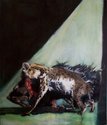Andrew Paul Wood – 8 December, 2009
There is something very German about what Wheeler is doing now – and there is, perhaps, little surprise in that given that Wheeler spent a longish period in Berlin (which is a very sensible thing for any aspiring artist to do).
Whopping great canvasses of nature red in tooth and claw – Pete Wheeler appears to be once more in love with paint. The scale of the paintings can best be described as romantic/heroic. The technique is starling and often technically daring. The subject matter is less certain: the Discovery Channel meets velvet painting – occasionally just a Native American or dreamcatcher shy of being a polar-fleece bedspread as in the case of a painting of a bald eagle. As a rule of thumb neither actors nor artists should probably work with children or animals. Risks are involved. Wheeler does it OK.
Lions and tigers and bears, oh my! Are the soft focus beasts simply arbitrary excuses to slap the paint down on canvas? Are they being knowingly ironic about kitsch (a bit trite these days)? Are they genuinely sentimental and naïf celebrations of nature’s predators? I suspect the truth lies somewhere in-between, though the artist is not being forthcoming. Each has a certain plausible deniability to it should it become a liability if and when the fashion changes.
In some ways, however, the subject is irrelevant to the act of mark making itself. A painting of a leopard functions as a good metaphor for this. Convincing leopard spots are damned difficult to pull off convincingly on this kind of scale (without looking like something from Bette Lynch’s wardrobe), requiring a certain amount of chutzpah, but Wheeler seems to manage it with big hairy-chested neoexpressionist gestures and drips and restricted palette in grungy autumnal greens and browns. It’s overwhelming in its sheer massiveness. Indeed, in the 1990s the roaring boys of Dunedin painting – including Wheeler and James Robinson - very much went in for a sort of paint-slathered punk Basquiat-esque variant on neoexpressionism. While Robinson seems to have turned into an ersatz Julian Schnabel, Wheeler has gone a different route.
There is something very German about what Wheeler is doing now – and there is, perhaps, little surprise in that given that Wheeler spent a longish period in Berlin (which is a very sensible thing for any aspiring artist to do). The kinds of artists I am thinking of specialise in smeary figuration in low key or off key palettes. Consider Gerhard Richter, Sigmar Polke, Georg Baselitz, Martin Kippenberger and Neo Rauch – the whole kit and caboodle from Capitalist Realism to the Leipzig school. It was, after all, East Germany that kept figurative painting alive while everyone else was following New York up the garden path to Ab Ex land. I’ll even chuck in Luc Tuymans too, even although he’s Belgian. I suppose you could call it Contemporary Mittel-European style twenty years on.
More to the point, the artist admits to being reinvigorated by Francis Bacon in the flesh (pardon the pun). Mind you, you would have to have the soul of a battery hen not to feel significantly moved by Bacon’s use of paint and general sense of existential anguish.
Wheeler’s paintings are, however, only vaguely comparable to Bacon in style; and no-one alive today (prove me wrong) is anything like as good as Bacon, therefore comparisons are probably futile. Wheeler strives for a similar sense of motion, and sometimes even the brilliant crimson slash of blood, but it comes out looking more like Sickert than Bacon which probably has more credibility for him in the long run. Sickert has been less done to death, despite all that Jack the Ripper nonsense.
I think, in general, I am somewhat ambivalent about the whole exercise. I like the paint, but there is a certain deadness to the subjects that doesn’t quite gel for me. Even a painting of some ambiguous big hyena ripping apart a wildebeest doesn’t really make me feel much when it probably should, and might have benefited more from the sensitive, almost fetishistic interpretations of Stubbs and Turner rather than David Attenborough – and this is the most Bacon-like of all the works. The positive side effect of this figurative fatigue is that it does put you off asking such empty, jaded old hat questions as “How far has the idea of art progressed from straight mimesis?” and “Is perception governed more by subjective conventions or ideological manipulation?” and forces you to look at the brushwork, which is the interesting bit.
The paint itself is full of energy and intensity, gesture and precision that suggests it knows where it’s going, but may not quite have got there yet. It’s still, however, entirely worth looking at. In the broader scheme of things, it’s hardly cutting edge stuff, but then again I get the impression Wheeler doesn’t intend it to be – he’s painting for himself rather than an audience. Generally the best painters do.





 Two Rooms presents a program of residencies and projects
Two Rooms presents a program of residencies and projects Advertising in this column
Advertising in this column



This Discussion has 0 comments.
Comment
Participate
Register to Participate.
Sign in
Sign in to an existing account.